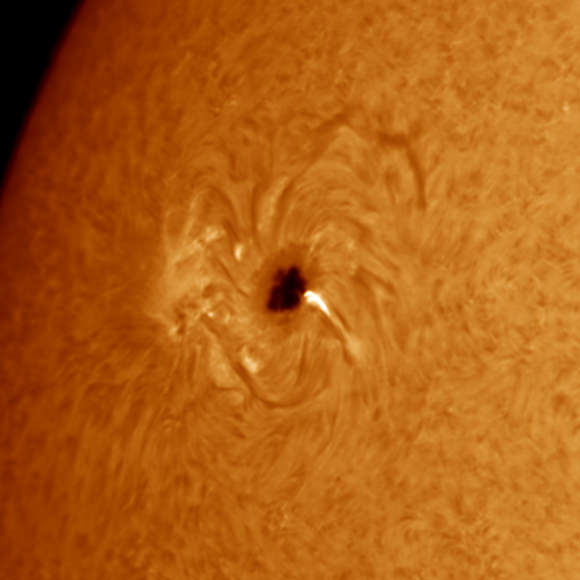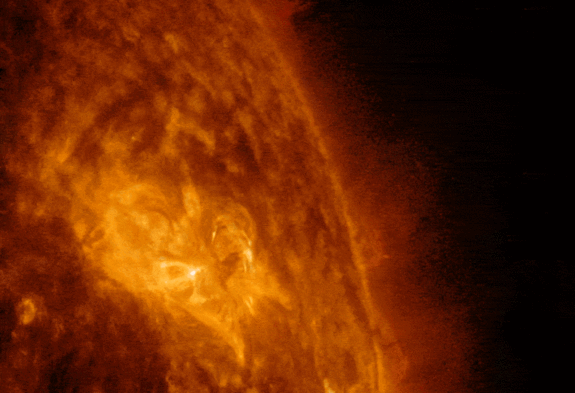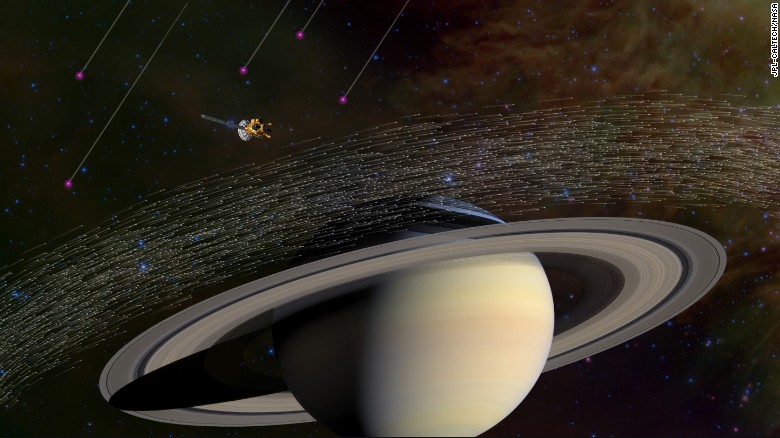NASA finds cosmic dust speeding through our solar system
By Jareen Imam, CNN
Updated 7:01 AM ET, Sun April 17, 2016
Detected at Saturn: dust that came from beyond our solar system
(CNN) NASA just discovered some special particles floating in our cosmic neighborhood.
The Cassini spacecraft, which has been orbiting Saturn since 2004, has detected alien dust that came from outside our solar system.
Scientists suspect that this dust is interstellar in origin because it moves fast and in different directions, compared to the dust found on Saturn, according to a recently published report in the Journal of Science. And although this alien dust was faint, it had a distinct signature.
Cassini has been studying the gas giant and its moons. During its tenure, the spacecraft used its cosmic dust analyzer to sample millions of ice-rich dust grains.
Understanding the makeup of interstellar dust can help scientists learn more about how stars, planets and, ultimately, our universe has taken shape.
Most of those dust came from Saturn's active moon Enceladus. The moon, which has a global ocean and other geographic features, has active jets that spray dust particles into space.
Out of the millions of cosmic particles the spacecraft collected, 36 were special. These were alien dust grains. Scientists concluded that the dust came from interstellar space -- the void that exists between stars.
Scientists have come across alien dust in our solar system before, so the discovery is not unprecedented. In the 1990s, international researchers from the ESA/NASA Ulysses mission made an observation of foreign dust, which was traced back to an interstellar cloud.
"From that discovery, we always hoped we would be able to detect these interstellar interlopers at Saturn with Cassini. We knew that if we looked in the right direction, we should find them," said Nicolas Altobelli, Cassini project scientist at the European Space Agency and lead author of the study.
These microscopic dust particles were traveling at high speed through space when Cassini detected them. They were moving at a rate of 45,000 mph, a speed so fast the dust can essentially avoid being trapped by our sun's gravitational forces.
Unlike previous missions, Cassini was able to analyze the alien dust, which revealed the dust grains were made of minerals, not ice. The composition was primarily rock-forming elements such has magnesium, silicon, iron and calcium.
Stardust found in some meteorites are generally pristine and diverse because they have been preserved since the birth of our universe. But the particles Cassini picked up are not like that.
Instead, these particles pretty much have the same chemical makeup, which is surprising. Scientists theorize that when the dust was created from a dying star, it was destroyed and reformed, shaping similar cosmic particles every time.
"Cosmic dust is produced when stars die, but with the vast range of types of stars in the universe, we naturally expected to encounter a huge range of dust types over the long period of our study," said Frank Postberg of the University of Heidelberg, a co-author of the paper and co-investigator of Cassini's dust analyzer.
------------------
See CNN for more in-depth coverage of this story:
Code:http://www.cnn.com/2016/04/16/tech/cosmic-dust-nasa-cassini-irpt/index.html
 |
 |
|
|||||||||||
 |
 |
||||||||||||
|
|
|
|
|
|
|
||||||||
 |
|
|
|
|
|
 |
|||||||
|
|
|
|
|||||||||||
|
|
|||||||||||||
|
|
|
|
|
|
|
|
|
|
|
|
|
|
|
Results 191 to 200 of 679
-
04-17-2016, 01:15 PM #191
Last edited by ilan; 04-17-2016 at 01:26 PM.
-
04-18-2016, 03:04 PM #192Huge Sunspot Turns Earthward
11 Apr, 2016 by David Dickinson (Universe Today)

Our seemly placid host star is just full of surprises.
Just one week ago, it looked like we were set to enter the first spotless stretch of 2016, as the Earthward face of Sol presented one lonely sunspot group going ’round the limb, headed towards the solar far side.
Ah, but a few days can make all the difference when it comes to solar astronomy. Late Sunday night we were flooded with new solar images taken by observers worldwide, showing the emergence of sunspot active region AR 2529. This monster spot is easily already number one with a bullet for 2016.
And as Gadi Eidelheit based in Israel notes, you can already see AR 2529 without magnification, using solar filter glasses:
How big will AR 2529 get? One thing is for certain: it’ll be turned directly Earthward in just a few days. AR 2529 currently harbors the potential for C-class flares, and could send some love our way in the form of solar flares, and just maybe a coronal mass ejection or two. This also means we could be in for a fine aurora display later this weekend for folks living in high latitudes.
The evolution of sunspot active region
AR 2529 over the past weekend. Image credit: NASA/SDO
This development certainly goes against the prevailing trend. One swallow certainly does not make a spring, and AR 2529 appeared just as we were sliding back towards another solar activity minimum for sunspot cycle 24. The last solar minimum back in 2009 was the deepest in over a century, and some heliophysicists speculate that Cycle #25 may be absent all together. Another idea in the solar astronomy community is that perhaps the classic use of sunspot numbers does not completely describe current solar activity, and perhaps the orientation of what’s known as the solar heliospheric current sheet paints a more accurate picture.
Can you see it? We urge all owners of solar scopes and eclipse glasses to get out and try to spot AR 2529 this week. Welder’s glass #14 works great as well. Do not, of course, stare at the Sun unprotected, or attempt the long list of unsafe methods we’ve heard of over the years, to include smoked glass, sunglasses, exposed film negatives, screw-on eyepiece filters, etc. All of these are dangerous.

Sunspot Active Region 2529, along with a dramatic white-light flare
imaged on April 10th. Image Credit: Chris Kennedy.
You can also safely project the image of the Sun onto a piece of paper using binoculars and see large sunspots… or you can watch the daily growth and progression of AR 2529 via NASA’s Spaceweather website or the joint NASA/ESA Solar Heliospheric Observatory (SOHO) mission.
------------------------
Tribute to the sunspot:
Code:https://www.youtube.com/watch?v=uRWyxzmNdJc
Last edited by ilan; 04-18-2016 at 09:41 PM.
-
04-19-2016, 06:04 PM #193Image of a solar flare erupting from AR 2529...

This footage from NASA’s Solar Dynamics Observatory spacecraft shows
the heart-shaped sunspot AR 2529 firing off an M6.7 solar flare on April 17, 2016.
Credit: NASA/SDO/Goddard
Last edited by ilan; 04-19-2016 at 06:10 PM.
-
04-21-2016, 01:55 AM #194

April Full Pink Moon to Be Visible This Week Across the US
The full moon will peak on Friday at 1:25 a.m. EDT. While the moon doesn’t actually change color, Pink Moon is the nickname given to the April full moon. It is also called the Seed Moon or Egg Moon.
Friday, April 22nd, 2016 brings us a Full Moon in Scorpio – and between Mars Retrograde, and the Full Moon, it may feel as though you’re being pulled in all different directions.
Unresolved issues from the past are becoming ever-present in the present, and worries of the future may cause you to feel like you’re carrying the weight of the world on your shoulders. While it may seem like everything is falling apart, in reality – things are falling together, and whatever is breaking down right now, is creating new room for a more expansive experience.
Astrologically speaking, this Full Moon creates a standoff between Taurus and Scorpio, which calls for us to find balance and personal security, but to check our ego and do some deep work on our soul. Everything is changing rapidly, but as things shift their shape – don’t forget to stay grounded, and try not to allow the energy to thwart your equilibrium. If you keep your balance, you may find a pleasant surprise over the weekend when Venus joins with Uranus, which will open your heart and mind to abundance…but don’t be too pushy, practice the art of allowing and let it be what it’s meant to be.
April’s Full Moon is also referred to as the Full Pink Moon, which carries a very powerful energetic signature…
“The kind of grass that is called pink or wild ground phlox is one of the earliest, widespread flowers of the spring. Other names for this same moon were the Full Sprouting Grass Moon, the Egg Moon and — among coastal tribes — the Full Fish Moon, when the shad came upstream to spawn.
April’s full moon will also coincide with the peak of the annual Lyrid meteor shower but don’t expect a dazzling display of shooting stars. The bright moonlight will wash out most meteors this year. The moon also will NOT turn green this year despite an Internet rumor. ” (via Space.com)
In using the nature energies that surround this Full Moon as a guide to deepen the appreciation and understanding of the shape of things to come – both the sprouting grass, and the egg can serve as great metaphors for guidance. For grass to grow, a seed must be planted, cared for, and tended to…while it takes time, light and care – eventually the grass breaks through the dirt/darkness, and reaches the surface to stand tall and proud in the sunshine.
The same thought process can be applied to the egg as the “teacher” and a great quote to serve as a mantra for this time period is the following “if an egg is broken by an outside force, life ends. If an egg is broken from an inside force, life begins. Great things happen from the inside”.
Stand tall and proud, look within and allow what’s meant to manifest, remember to stay balanced and calm – and not allow the ego to trick you. Look deep into your soul, enjoy the change of seasons, fall in to what’s meant to be and let go of what’s not.I gather darkness to please me...
-
04-21-2016, 12:04 PM #195
Purdy and some good philosophical meanderings as well
 Thanks, Cap...
Thanks, Cap...
-
04-22-2016, 12:20 PM #196Researchers Spy Traces of a Supernova In Earth-bound Cosmic Rays
Cosmic rays pelting the upper atmosphere are evidence of a recent supernova in the cosmic neighborhood.
By John Wenz | Published: Thursday, April 21, 2016

Cosmic rays are accelerated toward Earth by the same kind of supernova explosions
that carved this bubble into the Large Magellanic Cloud.
Gemini South Telescope in Chile; composite by Travis Rector of the University of Alaska Anchorage
Sometime in the last few million years, a not-so-far-off supernova sent charged particles known as cosmic rays out in all directions. The scattered, stripped nuclei of radioactive iron isotopes eventually made their way to Earth as part of a larger stream of material. Now, researchers at Washington University in St. Louis have found traces of this stream bombarding our planet, bringing interstellar atomic debris crashing into Earth.
In a paper published today in Science, the researchers report on the findings of 17 years worth of observation from the Cosmic Ray Isotope Spectrometer aboard NASA’s ACE craft. During that time, it detected 15 individual nuclei of iron-60, a by-product of supernova explosions. Because iron-60 tends to decay quickly, and cosmic rays don’t quite reach the speed of light, that means the supernova was likely local.Last edited by ilan; 04-22-2016 at 12:23 PM.
-
04-23-2016, 08:37 PM #197Member


- Join Date
- Oct 2015
- Location
- YES
- Posts
- 81
- Rep Power
- 14
Thank`s ilan for your recent array of superb! pics...... I especially love the sunspot phenomenon one.
-
04-23-2016, 08:47 PM #198
It's amazing that hot spinning orb is only a few feet away (relatively speaking, of course) and it's kicking up these incredible storms yet we hardly notice.
Last edited by ilan; 04-23-2016 at 08:50 PM.
-
04-25-2016, 06:47 PM #199Cosmic beacons reveal the Milky Way’s ancient core
Astronomers have discovered that the central 2,000 light-years within the Milky Way Galaxy hosts an ancient population of stars.
By Leibniz Institute for Astrophysics, Potsdam, Germany | Published: Friday, April 22, 2016

An international team of astronomers led by Andrea Kunder of the Leibniz Institute for Astrophysics Potsdam (AIP) in Germany has discovered that the central 2,000 light-years within the Milky Way Galaxy hosts an ancient population of stars. These stars are more than 10 billion years old and their orbits in space preserve the early history of the formation of the Milky Way.
For the first time the team kinematically disentangled this ancient component from the stellar population that currently dominates the mass of the central galaxy. The astronomers used the AAOmega spectrograph on the Anglo Australian Telescope near Siding Spring, Australia, and focused on a well-known and ancient class of stars, called RR Lyrae variables. These stars pulsate in brightness roughly once a day, which make them more challenging to study than their static counterparts, but they have the advantage of being “standard candles.” RR Lyrae stars allow exact distance estimations and are found only in stellar populations more than 10 billion years old, for example, in ancient halo globular clusters. The velocities of hundreds of stars were simultaneously recorded toward the constellation Sagittarius over an area of the sky larger than the full Moon. The team therefore was able to use the age stamp on the stars to explore the conditions in the central part of our Milky Way when it was formed.
Just as London and Paris are built on more ancient Roman or even older remains, our Milky Way Galaxy also has multiple generations of stars that span the time from its formation to the present. Since heavy elements, referred to by astronomers as “metals,” are brewed in stars, subsequent stellar generations become more and more metal-rich. Therefore, the most ancient components of our Milky Way are expected to be metal-poor stars. Most of our galaxy’s central regions are dominated by metal-rich stars, meaning that they have approximately the same metal content as our Sun and are arrayed in a football-shaped structure called the “bar.” These stars in the bar were found to orbit in roughly the same direction around the galactic center. Hydrogen gas in the Milky Way also follows this rotation; hence, it was widely believed that all stars in the center would rotate in this way. But to the astronomers’ astonishment, the RR Lyrae stars do not follow football-shaped orbits, but have large random motions more consistent with their having formed at a great distance from the center of the Milky Way. “We expected to find that these stars rotate just like the rest of the bar,” states lead investigator Kunder. Juntai Shen of the Shanghai Astronomical Observatory said, “They account for only one percent of the total mass of the bar, but this even more ancient population of stars appears to have a completely different origin than other stars there, consistent with having been one of the first parts of the Milky Way to form.”
-----------------------------------
Ilan: I don't feel quite as old after reading this.Last edited by ilan; 04-25-2016 at 06:49 PM.
-
04-25-2016, 06:58 PM #200Pinball Wizard












- Join Date
- Nov 2014
- Location
- yes
- Posts
- 9,529
- Rep Power
- 293
Nice Article, Thank you Ilan!!
Similar Threads
-
RCU model pics
By crazed 9.6 in forum BuzzTV RemotesReplies: 25Last Post: 01-05-2024, 10:41 PM -
BuzzTV e1 - pics
By Ryu in forum BuzzTV EssentialsReplies: 0Last Post: 02-01-2021, 01:06 AM -
Zx Pics
By Capt.Kangaroo in forum Formuler ZxReplies: 17Last Post: 09-21-2018, 02:38 PM -
This is cool pics
By Marley in forum Chit Chat LoungeReplies: 0Last Post: 03-06-2018, 06:41 PM -
Space Pics v.3
By Capt.Kangaroo in forum Deep SpaceReplies: 527Last Post: 05-25-2016, 02:09 PM





 Reply With Quote
Reply With Quote

